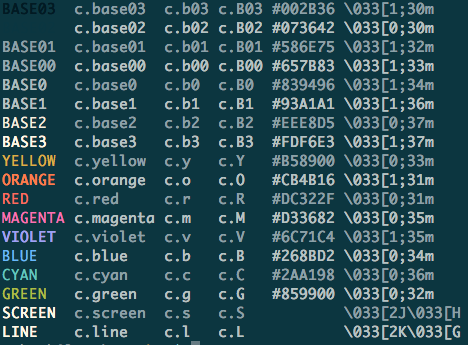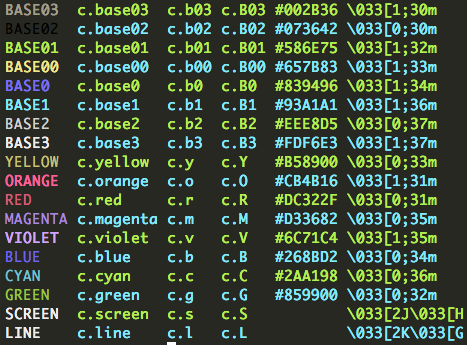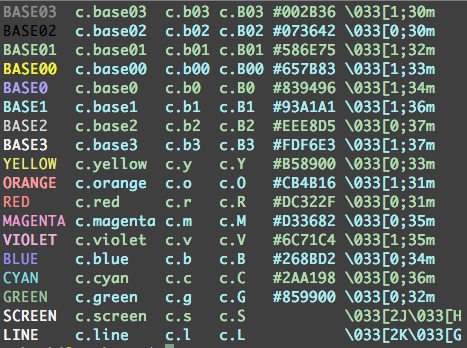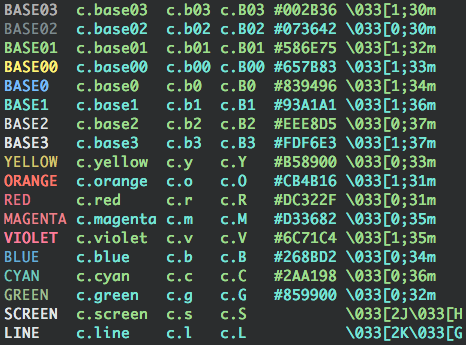solarized v1.2.5
Solarized

To see them solarized or colors commands are included.
Fastest Possible Terminal Colors, Period
Zero dependencies. Zero function calls. Only the fastest possible color solution using easy to use and remember aliases for escape sequence strings. It is physically impossible to create anything faster. (Maybe this is why the original ANSI Terminal developers used them in the first place. Maybe it is time to stop bikeshedding this and get something done.)
Easier to Include in Strings
Most other approaches require the string to be passed as an argument to a color function. Besides being remarkably slow to execute in comparison this is not as convenient as thinking of the colors as they actually are, markup-like tags that can be put in-line into strings of any length.
#!/usr/bin/env node
var c = require('solarized')
console.log(c.clear + c.yellow + 'Hello ' + c.cyan + 'world!' + c.reset)
console.log(c.y + 'Hello ' + c.c + 'world!' + c.x)Now that we have full template literal support the old function-based color solutions just break down and become even more impractical.
var story = `
Once upon a ${c.y}time${c.x} there was a boy who wanted
to ${c.b3}solarize${c.x} all the things.
`Assume ANSI Support in Terminal
Seriously, it has been 30+ years. Who still does not have an ANSI terminal? If somehow color has not been enabled that is fine. The makers of the original ANSI escapes used escapes for that reason since printing them to terminals that do not support color simple ignore them already. There is no need for any extra color support detection, at all.
Assume Solarized Theme
All terminal color packages have to make some assumptions and none will ever work with every possible theme. This package takes a convention over configuration approach and assumes those using it are building tools primarily for Ethan Schoonover’s amazing Solarized theme.
Be Usable on Most
Solarized output will still work with most other terminal themes.
Monokai

Zenburn

Chalk

No Lost Orange and Violet
You may have noticed that other terminal string styling packages leave out orange and violet. We don’t.
Includes Screen and Line Clearing
Two of the most overlooked—and useful—ANSI escape sequences clear the screen or just a single line. While technically these are not colors, we include it all the same. Simply printing them will clear faster than anything possible on an ANSI terminal. Combining this with other writes provides for rudimentary animation possibilities.
20 Lines of Code
That’s right, you don’t even need this module really. Just cut and paste some variation of the following right into your own code. We created the node module to be seen and encourage people to stop using heavier terminal color solutions. We have also included a Mac solarized-dark.terminal and a few other files that match it.
Node
m = module.exports
m.base03 = m.b03 = m.Base03 = m.B03 = '\x1b[1;30m'
m.base02 = m.b02 = m.Base02 = m.B02 = '\x1b[0;30m'
m.base01 = m.b01 = m.Base01 = m.B01 = '\x1b[1;32m'
m.base00 = m.b00 = m.Base00 = m.B00 = '\x1b[1;33m'
m.base0 = m.b0 = m.Base0 = m.B0 = '\x1b[1;34m'
m.base1 = m.b1 = m.Base1 = m.B1 = '\x1b[1;36m'
m.base2 = m.b2 = m.Base2 = m.B2 = '\x1b[0;37m'
m.base3 = m.b3 = m.Base3 = m.B3 = '\x1b[1;37m'
m.yellow = m.y = m.Yellow = m.Y = '\x1b[0;33m'
m.orange = m.o = m.Orange = m.O = '\x1b[1;31m'
m.red = m.r = m.Red = m.R = '\x1b[0;31m'
m.magenta = m.m = m.Magenta = m.M = '\x1b[0;35m'
m.violet = m.v = m.Violet = m.V = '\x1b[1;35m'
m.blue = m.b = m.Blue = m.B = '\x1b[0;34m'
m.cyan = m.c = m.Cyan = m.C = '\x1b[0;36m'
m.green = m.g = m.Green = m.G = '\x1b[0;32m'
m.reset = m.x = m.Reset = m.X = '\x1b[0m'
m.screen = m.clear = m.Screen = m.Clear = m.s = m.S = '\x1b[2J\x1b[H'
m.line = m.l = m.Line = m.L = '\x1b[2K\x1b[G'
// nice when picking a random color
m.colors = [ m.yellow, m.orange, m.red, m.magenta, m.violet, m.blue,
m.cyan, m.green ]Go
This repo also has the Go equivalents so it can be used as follows or just cut and paste into your own code.
package main
import (
c "github.com/skilstak/solarized"
"fmt"
)
func main() {
fmt.Println(c.Screen + c.R + "Hello " + c.Y + "world!")
}Here’s the whole Go code:
package solarized
const (
Base03 = "\033[1;30m"
B03 = Base03
Base02 = "\033[0;30m"
B02 = Base02
Base01 = "\033[1;32m"
B01 = Base01
Base00 = "\033[1;33m"
B00 = Base00
Base0 = "\033[1;34m"
B0 = Base0
Base1 = "\033[1;36m"
B1 = Base1
Base2 = "\033[0;37m"
B2 = Base2
Base3 = "\033[1;37m"
B3 = Base3
Yellow = "\033[0;33m"
Y = Yellow
Orange = "\033[1;31m"
O = Orange
Red = "\033[0;31m"
R = Red
Magenta = "\033[0;35m"
M = Magenta
Violet = "\033[1;35m"
V = Violet
Blue = "\033[0;34m"
B = Blue
Cyan = "\033[0;36m"
C = Cyan
Green = "\033[0;32m"
G = Green
Reset = "\033[0m"
X = Reset
Screen = "\033[2J\033[H"
S = Screen
Clear = Screen
Line = "\033[2K\033[G"
L = Line
Clearline = Line
)
var Colors = []string{Y, O, R, M, V, B, C, G}Python
#!/usr/bin/env python3
import solarized as c
print(c.clear + c.yellow + 'Hello ' + c.cyan + 'world!' + c.reset)
print(c.y + 'Hello ' + c.Line + 'world!')Or cut and paste the source:
base03 = b03 = Base03 = B03 = '\x1b[1;30m'
base03 = b03 = Base03 = B03 = '\x1b[1;30m'
base02 = b02 = Base02 = B02 = '\x1b[0;30m'
base01 = b01 = Base01 = B01 = '\x1b[1;32m'
base00 = b00 = Base00 = B00 = '\x1b[1;33m'
base0 = b0 = Base0 = B0 = '\x1b[1;34m'
base1 = b1 = Base1 = B1 = '\x1b[1;36m'
base2 = b2 = Base2 = B2 = '\x1b[0;37m'
base3 = b3 = Base3 = B3 = '\x1b[1;37m'
yellow = y = Yellow = Y = '\x1b[0;33m'
orange = o = Orange = O = '\x1b[1;31m'
red = r = Red = R = '\x1b[0;31m'
magenta = m = Magenta = M = '\x1b[0;35m'
violet = v = Violet = V = '\x1b[1;35m'
blue = b = Blue = B = '\x1b[0;34m'
cyan = c = Cyan = C = '\x1b[0;36m'
green = g = Green = G = '\x1b[0;32m'
reset = x = Reset = X = '\x1b[0m'
screen = clear = Screen = Clear = s = S = '\x1b[2J\x1b[H'
line = l = Line = L = '\x1b[2K\x1b[G'
colors = [ y, o, r, m, v, b, c, g ]